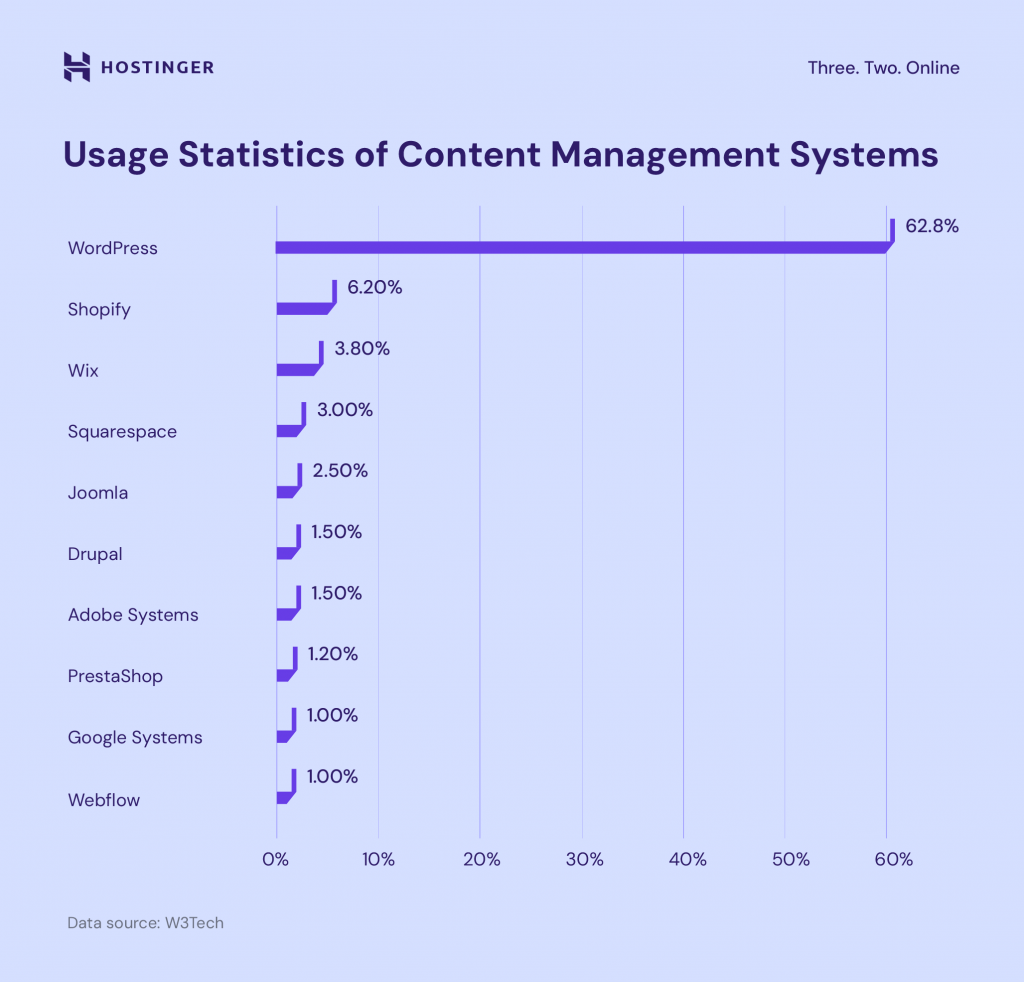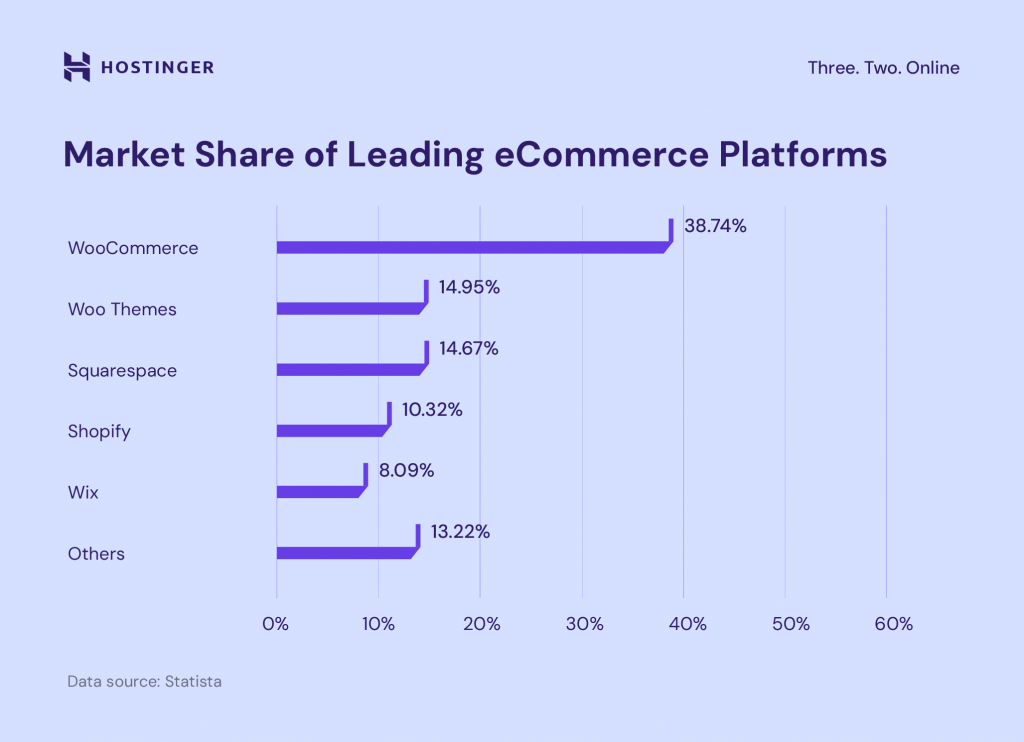Top 23 WordPress Statistics: Defining Trends and Insights for 2025

Initially created as a blogging platform, WordPress has become the most popular content management system suitable for any website type.
Whether it’s a simple blog, a feature-packed eCommerce store, or an online portfolio, WordPress offers a rich suite of plugins and themes for creating a website easily and establishing a strong online presence.
If you’re looking to make the most of this platform, keep reading. We’ll reveal some important WordPress statistics and trends you should know in 2025.
Top 10 WordPress Stats You Should Know
- WordPress is used by 43.4% of all websites. Among those created with a known CMS, the market share is even higher – 62.8%.
- There are over 810 million WordPress websites.
- WordPress searches have a global monthly volume of 2.6 million, which can bring around 323,000 visits.
- The WordPress Directory currently offers around 60,000 free plugins and 12,000 free themes.
- WooCommerce is the most popular eCommerce software platform with a 38.74% market share.
- There are over 4.6 million stores built with WooCommerce today, which is equivalent to 9.1% of all eCommerce sites.
- On average, a WordPress site is attacked every 22 minutes.
- Outdated plugins are responsible for 92% of WordPress vulnerability reports.
- Malware and unauthorized backdoor access are the two most common WordPress hacking methods.
- There have been more than 1,200 WordCamps held across 395 cities in 65 countries to date.
Read on to learn more about the platform’s market share, eCommerce trends, growing community, and more.
WordPress Usage Statistics
Still looking for the right site-building platform? These WordPress usage statistics will give you a better idea of why using WordPress is in your best interest.
1. Around 43% of All Websites Use WordPress
WordPress is the most popular website-making platform, powering nearly half (43.4%) of all websites – an increase of more than 25% since 2013. This dominance aligns with broader blogging trends, where over 600 million blogs worldwide drive the growing demand for powerful and scalable solutions.
Various factors contribute to WordPress’s popularity, including its user-friendly interface, extensive customization options, strong community support, and scalability for different website types.
2. WordPress Dominates the CMS Market With a 62.8% Share

Over the past decades, WordPress has consistently been the fastest-growing CMS.
Today, it has a global CMS market share of 62.8%, which is 10 times higher than Shopify, its closest competitor (6.2%). Other popular site-building tools include Wix (3.8%), Squarespace (3%), and Joomla (2.5%).
3. Most WordPress Sites Run on the Latest Version
Version 6 is used by the vast majority of WordPress sites (81.2%), while 14.1% and 4.4% are running on Version 5 and 4, respectively. Only 0.3% of WordPress websites use Version 3.
The latest major update, WordPress 6.5 “Regina”, introduces a font library and plenty of Gutenberg improvements, making content creation even more seamless.
4. Over 10,000 New WordPress Sites Emerge on a Daily Basis
As of 2024, there are 810 million WordPress sites, and the number is still growing rapidly.
Although WordPress.org itself is free, you still need to secure a WordPress hosting plan and a domain name to build a WordPress site. Hostinger, a web hosting provider recommended by WordPress.org, includes a custom domain name for free for the first year with yearly plans.
As a matter of fact, more than 10,000 WordPress websites are published daily through Hostinger alone. In total, out of the 6,198,185 websites hosted at Hostinger, 3,415,556 are WordPress websites (55.11%).

5. WordPress.com Is Popular for Blogging
Not to be confused with the open-source WordPress.org, WordPress.com is a blogging platform that handles all the technical aspects of site creation. This enables beginners to focus solely on producing content.
Given its ease of use, it’s no surprise that WordPress.com users published over 52.3 million blog posts and more than 4.9 million web pages in January 2024.
The engagement for WordPress.com content is also high, averaging almost 50 million comments per month during 2023 alone.
6. WordPress Search Volume Reaches 3.2 Million Monthly

WordPress isn’t a one-hit wonder. Despite an influx of new site builders and content management systems, people still show a strong interest in WordPress.
Between January 14 and February 10, 2024, there were 3.2 million WordPress searches on Google, indicating the platform’s widespread popularity and relevance.
WordPress Plugins and Themes Statistics
One of the key selling points of WordPress is the amount of free add-ons it offers. There’s a plugin for almost any functionality you need, and it’s easy to customize your site’s look with a unique theme.
The following WordPress statistics will reveal the current state of WordPress plugins and themes, helping you decide which ones to install.
7. There Are 59 Thousand Free Plugins in the WordPress Directory
If you’re a blogger or a business owner on a tight budget, you don’t have to spend money on web developers.
The WordPress Plugin Directory currently features 59,639 free plugins, providing an easy and cost-effective way to enhance your site’s functionality.
That said, having too many active plugins can slow down your website or even make it unresponsive.
8. Yoast SEO Is the Most Installed and Reviewed WordPress Plugin
The SEO plugin has over 5 million installations and around 25,000 user reviews, averaging a rating of 4.8 out of 5.
Plugins like WooCommerce, Jetpack, Akismet Anti Spam, Contact Form 7, and Wordfence Security also have a similar number of active users.
9. Only 62 Plugins Have Over 1 Million Active Installations
While there are over 59 thousand plugins available, only 62 of them have successfully reached the 1 million mark.
Those include some of the best WordPress plugins you might be familiar with, such as All in One SEO (AIOSEO), MonsterInsights, LiteSpeed Cache, and Starter Templates for Astra.
10. Nearly 12 Thousand Free Themes Are Available on WordPress
WordPress makes website design easy, offering around 12,000 free themes you can customize to your liking.
You can also download premium themes from third-party marketplaces like ThemeForest. It has about 17,000 themes in various categories, costing $5-299/license.
11. Astra Is One of the Best Free WordPress Themes
With over 1 million active downloads and more than 5,000 reviews, Astra is one of the most popular free WordPress themes on the market.
Its lightweight nature and compatibility with popular page builders are among the many reasons why it has become such a favorite among WordPress users. Plus, Astra has over 100 site templates optimized for search engines, making it easier to attract visitors.
12. Among Hostinger Clients, LiteSpeed Cache Is the Most Popular WordPress Plugin
Over 2 million Hostinger clients use LiteSpeed Cache on their WordPress websites, underscoring the importance of a fast-loading site. Other popular plugins include Elementor (2.2 million users) and WPForms Lite (1.6 million users).
Twenty-Twenty-Two remains the most popular WordPress theme, used by over 2.4 million Hostinger clients. Astra (806,717 users) and Elementor (586,111 users) are also crowd favorites.
WordPress eCommerce Statistics
For small businesses, establishing a strong digital presence has become a necessity rather than an option. According to the latest eCommerce statistics, 56.6% of customers prefer shopping online instead of in-store.
In this section, we’ve compiled four WordPress eCommerce usage statistics to guide you in building a thriving eCommerce site.
13. WooCommerce Stores Make Up 9.1% of All eCommerce Sites
WooCommerce is by far the most popular eCommerce platform for WordPress. The plugin is used by 21% of WordPress sites and 9.1% of all eCommerce stores on the internet.
Agoda, Cisco, and Nvidia are among the top brands that use WooCommerce to build a high-functioning and feature-packed eCommerce website.

14. More Than 290 Million Users Have Downloaded WooCommerce
Ever since its inception, WooCommerce has been installed by 292,096,298 WordPress users, averaging roughly 30,000 downloads per day.
These staggering stats show WooCommerce’s ability to stay on top of its game, even with tons of up-and-coming eCommerce platforms bursting onto the scene.
15. WooCommerce Leads the eCommerce Platform Market Share
In 2023, WooCommerce was the leading eCommerce software platform, making up 38.74% of the total market share. Woo Themes, which is also owned by WooCommerce’s parent company Automattic, came second with 14.95%.
Other eCommerce platforms that made the list include Squarespace Online Stores (14.67%), Shopify (10.32%), and Wix Stores (8.09%).
16. Over 4.6 Million Stores Are Running on WooCommerce
There’s no doubt that WooCommerce plays a huge role in the online retail sector. In fact, there are 4,648,008 live eCommerce sites built with WooCommerce as of 2024 Q1.
Product-wise, home appliances and apparel lead the way with around 250,000 stores each, followed by business and industrial (166,000), as well as food and beverage (157,000).
WordPress Security Statistics
Despite being one of the safest content management systems, WordPress isn’t immune to cyber attacks and security vulnerabilities.
To protect your site from threats, let’s discuss some important WordPress security statistics.
17. A WordPress Site Is Attacked Every 22 Minutes
Keeping your site secure goes a long way in gaining customer trust and maintaining a positive reputation for your brand.
Unfortunately, issues like weak passwords and vulnerable plugins or themes consistently provide entry points for hackers to access your site.
While there’s no exact number, experts estimate that roughly 13,000 WordPress sites are hacked on a daily basis. To put it into perspective, that number equals 390,000 attacks per month and 4.7 million per year.
18. WordPress Plugins Are Responsible for 92% of Vulnerability Reports
According to WP Scan, around 38,000 WordPress vulnerabilities have been reported to date. The vast majority (92%) came from WordPress plugins, while WordPress core and themes account for only 3% and 5%, respectively.
19. Malware Is the Most Common Type of Hacking Method
Sucuri, one of the leading WordPress firewall plugins, found that 72.7% of site infections were caused by malware. Unauthorized backdoor access and SEO spam come next, accounting for 69.6% and 46.7% of all WordPress hacks.
The least common types of hacking methods include phishing (8.1%), defacements (6.7%), mailers (5.9%), and droppers (1%).
20. Wordfence Blocks 330 Million Hits Every Day
When it comes to website protection, there aren’t many plugins that do a better job than Wordfence.
At the time of writing this article, the plugin successfully blocked over 6.4 billion brute-force attacks, more than 4.2 billion exploit attempts, and around 142,000 malicious IP addresses over the last 30 days. It also detected over 4.7 million malicious files.
WordPress Community and Events
Every year, WordPress holds a series of conferences called WordCamps, bringing together WordPress contributors, users, and developers from all around the globe.
Read on to learn interesting facts about these events and their importance in shaping the WordPress community.
21. The First WordCamp Was Organized in 2006
18 years ago, WordPress founder Matt Mullenweg held the first-ever WordCamp in San Fransisco. Since then, local WordPress communities have organized hundreds of their own events.
22. WordCamps Have Been Held Across 395 Cities in 65 Countries
To date, there here have been 1,210 WordCamps held across 395 cities, 65 countries, and 6 continents.
These numbers are set to grow even higher, with 18 upcoming WordPress-related events scheduled for 2024. Notable ones include WordCamp Asia in March, WordCamp Europe in June, and WordCamp US in September.
23. WordPress Supports a Wide Range of Local Languages
Given its large worldwide community and global appeal, WordPress takes content localization seriously.
The platform’s translation teams have successfully released 208 locales, including Arabic, Chinese, Indonesian, Japanese, French, German, and Spanish.
Sources
- WordPress.org
- WordPress.com
- W3Techs
- WordCamp Central
- Statista
- KeyCDN
- Colorlib
- Wordfence
- Store Leads
- Meetanshi
- Envato Market
- Themeisle
- Google Trends
- Techjury
Conclusion
WordPress is the most popular website-building platform, powering nearly half of all live websites. With more than 10,000 new WordPress websites being launched every day through Hostinger alone, the market share will only get bigger.
The statistics we’ve curated in this article, combined with the support provided by the WordPress community, should give you enough knowledge and guidance to kickstart your online journey.
Should you have any questions, explore our WordPress tutorial or leave a comment below. Good luck!
WordPress Statistics FAQ
Find answers to commonly asked questions about WordPress usage statistics.
What Percentage of People Use WordPress?
Based on the latest data by W3Techs, 43.4% of all websites use WordPress as their content management system. Among sites made with a known CMS, the percentage is even higher – 62.8%.
Is WordPress Still Growing?
Yes, more than 10,000 new WordPress websites are being published through Hostinger alone on a daily basis. According to Google Trends, WordPress’s search volume has also been stable for the past 12 months.
More importantly, with 18 global WordPress-related events scheduled for this year, the WordPress community is expected to continue growing.
How Many Websites Use WordPress?
As of 2024, there are 810 million WordPress websites. Around 20% (approximately 163.5 million) of those are eCommerce stores built using WooCommerce.





